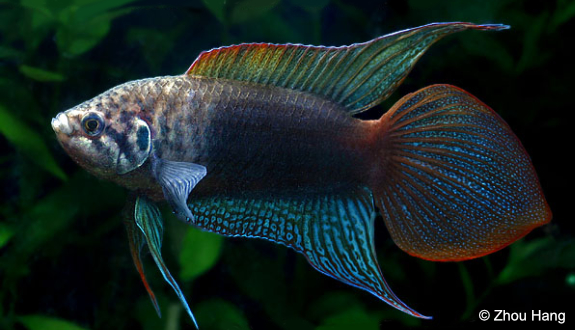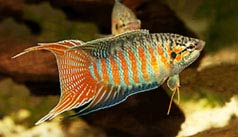

Alternative species (click on the thumbnail to see the card)
Names
Scientific name
Macropodus ocellatus
Macropodus chinensis
Polyacanthus paludosus
Polyacanthus opercularis
Macropodus ctenopsoides
Common name
Round-tailed paradise fish
Roundtail paradisefish
Chinese fighting fish
Roter China-Macropode (DE)
Origin

Origin: North Korea, East China, Japan
Biotope: Asian
Dimorphism

Males are more colorful, larger and slimmer than females. They also have dark vertical bars on the head and back of the body
Group

Osphronemidae
Volume

80 L / 18 Imp Gal / 21 US Gal
Parameters

T°: 4 to 28°C or 39 to 82°F
pH: 7 to 7.5
Hardness: 9 to 20°dGH
Difficulty

Easy
Size

Male 8 to 9cm (3.15 to 3.6")
Female 6 to 7cm (2.4 to 2.8")
Longevity

5 to 8 years
Living zone
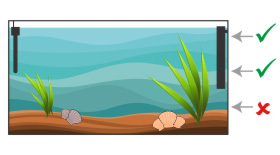
Middle and top
Individuals
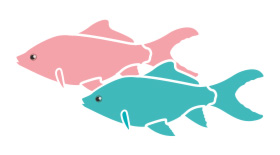
2 (couple)
Food
How to feed the Roundtail paradisefish?
Food
How to feed the Roundtail paradisefish?
This fish is one of the omnivorous species with an insectivorous tendency. It is not difficult to feed and accepts a wide range of foods. However, there is a clear preference for live prey, which should be distributed at least twice a week (otherwise frozen prey). For example, distribute snails, mosquito larvae, small worms... From time to time, supplement with a small vegetable part, for example by using Goldfish flakes.
Behavior
What kind of behavior does the Roundtail paradisefish have?
Behavior
What kind of behavior does the Roundtail paradisefish have?
Much less aggressive than its cousin Macropodus opercularis, this fish is calm and finally not very active (except during the reproduction period). This does not prevent it from being rather curious: take advantage of this trait to tame it (some come to eat in the hand of their handler)!
It evolves mainly under the surface of the water.
Cohabitation
Who can live with the Roundtail paradisefish?
Cohabitation
Who can live with the Roundtail paradisefish?
Paradise fish like to live in small groups (150 liters / 33 Imp Gal / 40 US Gal) or couples (80 liters / 18 Imp Gal / 21 US Gal). On the other hand, cohabitation between males is not possible in aquariums because they cannot stand the presence of rivals. It can also be tricky to introduce a new member into the group. If you wish to add a specimen to your group, take it young enough because the chances of success are higher.
You can choose roommates from the peaceful, non-territorial fish. The Macropod is less tolerant of territorial species, even though it is never really aggressive. Finally, avoid large aggressive fish that could dominate and injure it. In any case, keep in mind that the Macropod needs a wintering period where the water temperature really needs to drop. Its roommates will have to be able to withstand this variation!
Breeding
How to breed the Roundtail paradisefish?
Breeding
How to breed the Roundtail paradisefish?
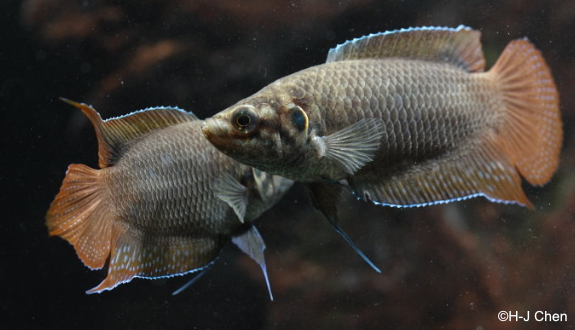
It is quite easy to breed this species, even if it is the least prolific of its genus.
To have a chance to have a breeding pair, you will have to maintain a group of at least 5 specimens. In good conditions and with a little bit of luck, a couple will form, you will not have to separate them anymore. Once you have clearly identified them, isolate them in an aquarium specially designed for breeding: this will protect the fry from possible predation, and it will also protect your population from the aggressiveness of the male.
Spawning takes place in the warm season, when the temperature starts to approach 20°C or 68°F. The temperature rise should be natural and gradual. Under good conditions, you can expect spawning from May to September.
The male ready to reproduce reinforces these colors to seduce the female. Conversely, the female will turn pale to become almost white. After courting the female, the male builds a bubble nest among the vegetation, preferably under large leaves. It is important that the current is very weak or even non-existent in this area so as not to destroy the nest which is very fragile.
After egg laying (which can last from 1 to 2 hours), the male keeps the nest and becomes very aggressive. Remove the female quickly. Incubation lasts 36 to 48 hours depending on the temperature. After hatching, Dad really takes care of his young and gathers them tirelessly in the nest. He protects them fiercely. Remove it as soon as the fry start to leave the nest.
Alternatively, let spawning occur in the overall aquarium and then retrieve the nest containing the fry (just before free swimming) with a cup and place it in a rearing tank.
The fry should be sorted and separated as they develop so that the larger fry do not eat the smaller ones (some fry may be twice the size of their siblings).
Feeding of the fry: infusing then nauplias of artemia, feeding 4 to 6 times.
Its aquarium
Which aquarium for the Roundtail paradisefish?
Its aquarium
Which aquarium for the Roundtail paradisefish?
In its natural environment, this fish lives in ponds or very slow-moving streams, places with dense vegetation. Recreate this environment by installing peat bog roots and by planting your aquarium (Myriophyllum Elodea densa, Ceratophyllum demersum, without forgetting floating plants such as Salvinia, Ceratapteris...). This will create hiding places for the female(s). Still leave enough space for swimming. Finally, note that a dark floor will enhance your fish.
On the filtration side, a small stirring of once the volume of the tank per hour is enough because the Macropod lives in stagnant water in nature, so it is disturbed by a too strong current. Direct the discharge of the filter in the lower part of the aquarium.
It is imperative to mark the different seasons even if the Macropod is in an aquarium: it should be cold in winter and quite warm in summer. The differences in temperature should in this case be marked enough, otherwise this will weaken this fish which will not be able to be maintained durably (linear temperatures cause skin diseases such as nodules or ulcers). It is therefore not useful to install a heater in the aquarium, but you will still have to lower the temperature in winter. To mark the seasons, the ideal would be: in the pond in autumn and winter and in the aquarium in spring and summer.
This species is able to live in an outdoor pond all year round. Be careful, the water height must be at least 1 meter so that the fish does not freeze in winter.
In pond, it is a host of choice: it is respectful of the vegetation and does not dig in the sand. In winter, it hardly moves at all: don't worry: it's normal! Its metabolism slows down considerably to get through the winter.
Good To know
Find all additional information!
Good To know
Find all additional information!
Its name "Round-tailed paradise fish" comes from its particularity: unlike other representatives of its genus, it has a rounded caudal (slightly spear-shaped for males).
The paradise fish has a complementary respiratory organ: a labyrinth. It is used to absorb oxygen from the ambient air, which allows it to survive in waters with very little oxygen.
It is very rare to find this species in trade.
Yours photos!
Comments
Sort by:
Please login to post comments
